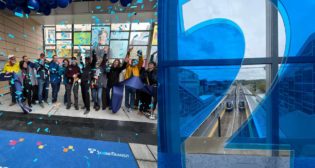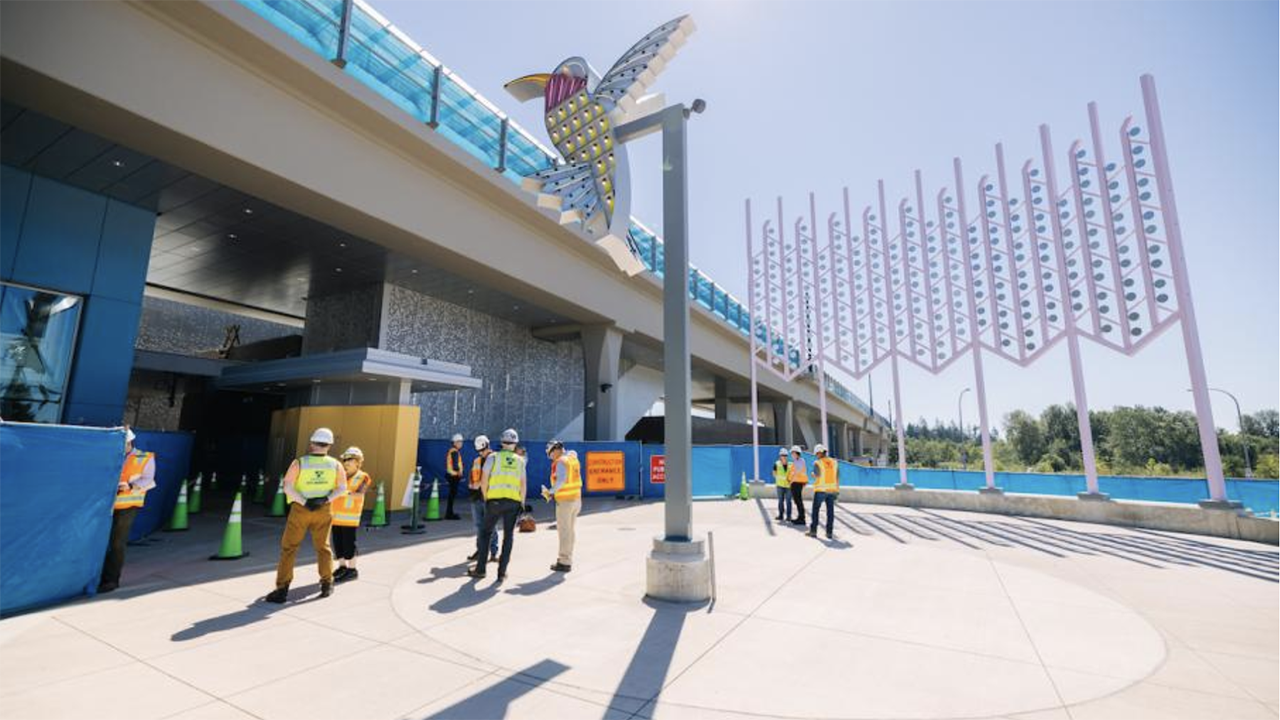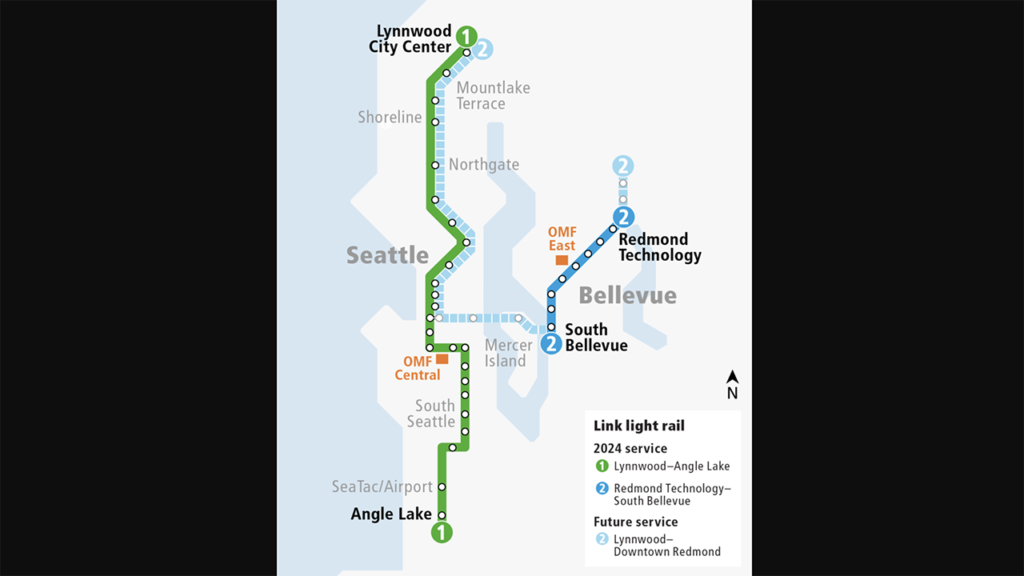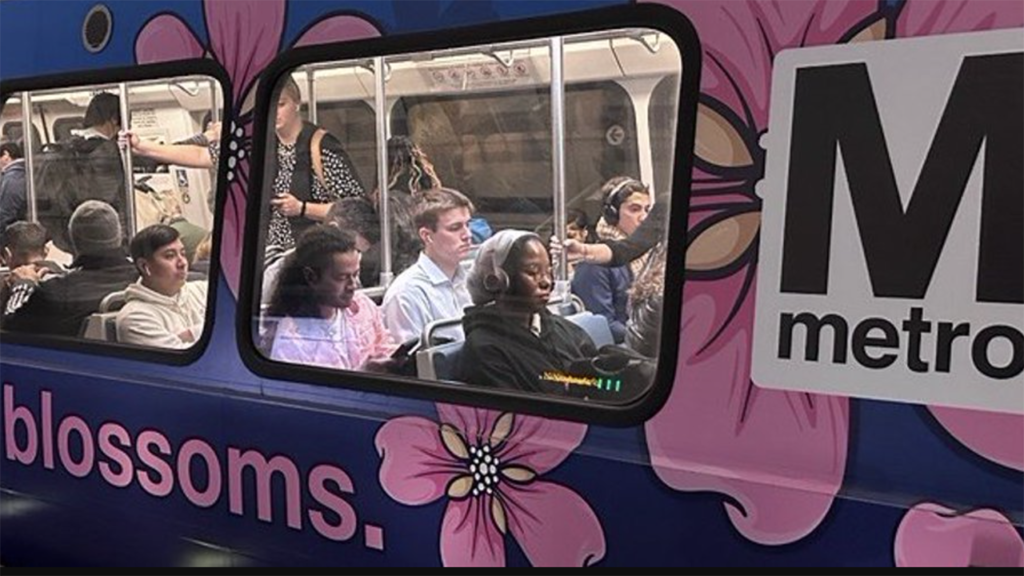
Transit Briefs: Denver RTD, Sound Transit, WMATA
Written by Marybeth Luczak, Executive Editor
The 8.5-mile Link 1 Line light rail extension from Northgate into Lynnwood will open Aug. 30, 2024, adding four new stations. (Sound Transit Photograph)
Denver (Colo.) Regional Transportation District (RTD) spearheads a pilot project that integrates trip planning and fare payment in the Transit app. Also, Washington’s Central Puget Sound Regional Transit Authority (Sound Transit) announces the launch date for Link 1 Line service to Lynnwood, Wash.; and Washington Metropolitan Area Transit Authority (WMATA) reports that efforts to reduce fare evasion and increase safety are working.
Denver RTD
Denver RTD on April 4 reported that it is working with the Colorado Department of Transportation’s (CDOT) Bustang services, Boulder BCycle, Lone Tree Link and Lyft scooters on a pilot project that integrates trip planning in the Transit app. Now riders can purchase fares and plan trips with end-to-end travel connections via RTD and its partners.
Denver RTD said it received a $687,000 grant from the Federal Transit Administration’s (FTA) Accelerating Innovative Mobility (AIM) program to fund the development and deployment of the pilot project, which will run through Feb. 28, 2026.
While the Transit app was initially released in 2012, the new features have been in development for the past year and were implemented in March, Denver RTD reported. The additions give riders the ability to plan travel, see fares for different legs of a trip within a suggested trip plan, and purchase fares across a variety of mobility providers within a single app.
“This is an exciting project because it brings so many different mobility options into one mobile application, reducing the friction associated with planning trips and purchasing fares between different modes,” Denver RTD Planning Project Manager Charlie Stanfield said. “For example, someone can now plan a trip from Colorado Springs to Denver International Airport, using both Bustang and RTD, without juggling multiple apps to plan the trip and purchase tickets.”
The pilot program is the first of its kind in the U.S., according to Denver RTD.
“Our hope is that this is the first step toward integrating public transportation options for Coloradans, and that we are able to build off the lessons learned from this project,” Stanfield said.
“This project paved the way to allow customers to see and purchase fares from multiple agencies in one trip in the app, and now other areas around the country where multiple providers intersect are looking to benefit from this work,” said David Block-Schachter, Chief Business Officer of Transit. “We also now show electric bikes and scooters separately from regular bikeshare in the app and use their speeds to calculate more-accurate ETAs in our trip plans. We’re excited for these developments to empower Coloradans to mix-and-match modes so that it’s even easier than before for them to travel car-free from A to B.”
When the project concludes after two years, Denver RTD and FTA will evaluate and measure the program’s success, according to the transit agency, which said the project was made possible through partnerships with the FTA, CDOT, Transit app, Masabi, Denver South Transportation Management Association, the city of Lone Tree, Via Mobility Services, Boulder BCycle and Lyft.
Sound Transit

The Link 1 Line light rail extension from Northgate into Lynnwood (see map above) will open Aug. 30, 2024, Sound Transit reported April 4. The 8.5-mile segment will add four stations—Shoreline South/148th, Shoreline North/185th, Mountlake Terrace, and Lynnwood City Center—and provide service between south Snohomish County and the University of Washington, downtown Seattle, the Eastside, Sea-Tac Airport, and more.
Sound Transit said the “pre-revenue service” phase of testing will begin April 15. It will include training for operators and maintenance staff, plus continued testing to ensure stations, tracks, utilities, and vehicles work together as expected in preparation for the start of service.
Once service begins, trains will run approximately every eight minutes during peak hours, according to Sound Transit, which added that 47,000–55,000 daily riders are expected to use the line by 2026.
Stacy & Witbeck/Kiewit/Hoffman JV and Skanska Constructors L300 JV are executing the civil construction on the extension. The $3.1 billion project budget includes up to $1.17 billion from a Full Funding Grant Agreement executed by the Federal Transit Administration (FTA). Additionally, the U.S. Department of Transportation’s Build America Bureau executed a $658 million low-interest loan supporting the project, including new light rail vehicles and support facilities.
“Today’s [April 4] announcement is the culmination of years of commitment and hard work on the part of Sound Transit’s project team, our contractors, and the construction workers,” Sound Transit CEO Goran Sparrman said. “They deserve our thanks for maintaining their focus on this project despite the COVID pandemic and the months-long concrete strike. I also want to thank our partners at King County and Community Transit for their ongoing collaboration in ensuring that we will have additional train capacity and transit options for riders when the Lynnwood extension opens.”
“By opening Lynnwood Link, Sound Transit takes another step to ensuring that people throughout Snohomish County and our entire region have access to fast, reliable transportation that avoids highway congestion while getting them where they need to go safely and efficiently,” said FTA Regional Administrator Susan Fletcher. “FTA is proud to have been a partner with Sound Transit in this critical project.”
Another light rail project—the full 2 Line, from downtown Seattle to Mercer Island, Bellevue and Redmond—was originally scheduled to open before Lynnwood Link, but Sound Transit said it is now targeting 2025. Why does opening order matter? “Because the 2 Line connection over Lake Washington will allow trains to access to our new storage and maintenance base in Bellevue,” Sound Transit said. “And that connection is critical to achieving the frequency we’d originally planned for Lynnwood (trains arriving as often as every 4 minutes in peak periods). So with only half the planned storage and maintenance capacity until the full 2 Line opens, we’ll be working creatively to provide as much 1 Line service as possible … With some schedule adjustments, new storage solutions, and extra bus options, we’ll be able to retain current Link service levels and limit crowding during the busiest times of day. That will mean trains continuing to arrive about every 8 minutes—even as the 1 Line will grow 35% longer overnight.”
WMATA

WMATA on April 4 reported seeing “positive trends in recent months with growing ridership and more customers paying their fares.” It attributes the success to its efforts to reduce fare evasion and increase safety.
Highlights include:
- 22 million bus and rail trips in March—14% higher than last year.
- Fare evasion is down 50% on rail compared with last year.
- Crime is down 19% in 2024 compared withlast year.
WMATA reported that the “commute is strong,” with peak commute hours in March seeing an average of 50,000 entries per hour (from 8 a.m.-9 a.m. and 5 p.m.-6 p.m. Monday through Thursday), a 25% increase over March 2023; and federal employee trips increasing by 33%. Additionally, weekends and special events are bringing a boost, the agency said. Weekend bus and rail ridership is above 2019 levels, thanks to more frequent service; Smithsonian Station recorded its busiest days since 2019 with 69,000 customers trips on Saturday, March 30; and Navy Yard hit a new post-pandemic high, with 40,000 customer trips on the day of the Nationals home opener, according to WMATA. Also, Union Station Metrorail ridership last month increased 23% over March 2023, and Dulles International Airport station ridership increased 38% over March 2023, WMATA noted.
“We have made great efforts to improve service and safety across all hours and all days of the week, and it is paying off,” WMATA General Manager and CEO Randy Clarke said. “We are moving customers in numbers that we haven’t seen in years, which boosts the economy, decreases congestion, and supports sustainability throughout the region. We thank everyone for taking transit and our team for delivering great service.”
Meanwhile, WMATA reported that paid ridership is up 24%, which it said means fare evasion is on the decline across the system. Among the steps the agency has taken to reduce fare evasion are:
- Retrofitting faregates at 33 of 98 stations so far, resulting in a 79% decrease in fare evasion at those locations.
- New, more reliable fareboxes on 60% of WMATA’s 1,500 buses, with a goal to upgrade all buses by the end of summer.
- Easier access to fare payment through mobile wallet; mobile payments are up 74% on rail and 35% on bus over last year.
- Simplified fare structure and reduced-fare programs for seniors, students, and low-income customers (MetroLift customers have taken more than 500,000 trips since the launch last July).
“Thanks to new legislation in the District, Metro Transit Police have stepped up fare enforcement efforts, writing hundreds of citations for fare evasion in March and arresting more than 20 people with outstanding warrants,” WMATA reported. Systemwide, fare evasion is down 50% compared to last year, it said.
With the addition of Special Police Officers and increased MTPD patrols throughout the system, crime is down 19% in 2024, according to WMATA. Also, the transit agency said it continues to look out for riders with 30,000 cameras systemwide and real-time communication channels to report safety concerns, including the MYMTPD text line.



